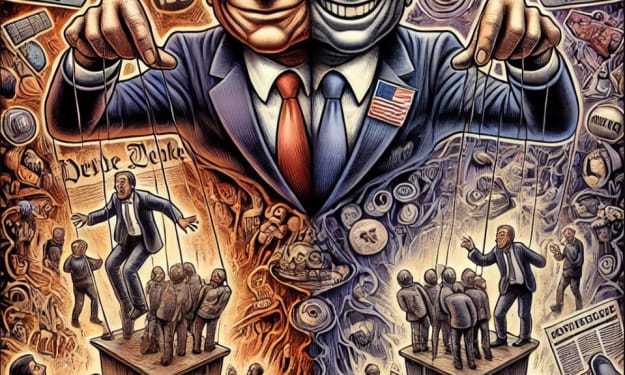Battling Borderline Madness
Navigating Life with BPD – A Deep Dive into the DSM-5 Criteria

Battling Borderline Madness: Navigating Life with BPD – A Deep Dive into the DSM-5 Criteria
Borderline Personality Disorder (BPD) is like trying to surf a tsunami on a pool float. It is a wild ride, full of emotional whirlpools and behavioural hurricanes that can make life feel like a never-ending soap opera – and not the kind where you end up rich and famous. Diagnosed with a nine-headed monster of criteria, those with BPD are not just riding waves of instability; they are trying to do it while keeping a sense of self intact. Strap in, folks, because we are diving into the deep end of what makes BPD tick, one insane criterion at a time.
Introduction: Welcome to the Circus of BPD
Ah, Borderline Personality Disorder (BPD), the mental health equivalent of trying to herd cats in a thunderstorm. It affects millions worldwide, turning what should be straightforward relationships and everyday tasks into emotional obstacle courses. If you have ever wondered why someone you know behaves like they are on an emotional roller coaster without a safety bar, understanding the criteria for BPD can be your guidebook. This disorder is not just “having a bad day” on repeat; it is like living in a soap opera with the dramatic flair of Shakespearean tragedy. And guess what? I won the lottery on this one, I have got nine for nine on the criteria. So, let us break down the nine circles of BPD hell as outlined in the DSM-5.
What is the DSM-5?
The DSM-5, or the Diagnostic and Statistical Manual of Mental Disorders, Fifth Edition, is a comprehensive guide used by healthcare professionals worldwide to diagnose and classify mental disorders. Published by the American Psychiatric Association in 2013, it serves as the standard reference for mental health diagnosis. The DSM-5 includes detailed criteria for diagnosing a wide range of mental health conditions, including mood disorders, anxiety disorders, psychotic disorders, and neurodevelopmental disorders. It also provides information on the prevalence, risk factors, and comorbidities of each disorder, helping clinicians make informed, accurate diagnoses and develop effective treatment plans.
Criteria for Diagnosing BPD
The DSM-5 outlines nine specific criteria for diagnosing BPD. A person must meet at least five of these criteria to be diagnosed with the disorder. These criteria cover a range of emotional, cognitive, and behavioural patterns that are characteristic of BPD.
1. Fear of Abandonment: The Bogeyman of BPD
To begin with, I'm a twin, and my sister did all the talking for me until I turned five. My first words at Nursery School in Keighley, at Guardhouse School, were a desperate cry: "Mummy, don't leave me!" It was a heartfelt moment as Mum was leaving me there.
Explanation: Imagine living with a constant, gnawing fear that everyone you care about will ditch you faster than you can say “relationship drama.” That is life with BPD’s fear of abandonment.
In-Depth Understanding: This is not just a “Don’t leave me!” moment. It is more like a perpetual terror that makes the idea of being alone feel worse than finding a spider in your cereal. It is both emotional and physical. Someone with BPD can spiral into anxiety if they think their mate is giving them the cold shoulder, leading to frantic efforts to cling on like their life depends on it.
Example: Picture this: your partner forgets to text back for a few hours. If you have BPD, this silence is not just a lapse in communication – it is a full-blown sign they are packing their bags. Cue the barrage of texts, desperate calls, and, if you are unlucky, a tearful confrontation over dinner about how “you're not going to leave me, right?!”
Associated Issues:
• Splitting: Individuals with BPD often engage in black-and-white thinking, known as splitting, where they see people as either all good or all bad. This can amplify their fear of abandonment, as any minor perceived slight can suddenly make someone seem entirely untrustworthy.
• "Favourite People": Many people with BPD have "favourite people" who they rely on heavily for emotional support. The fear of losing these key relationships can be overwhelming and drive desperate behaviours to maintain them. I hate splitting, truly hate it, especially when it is on Mrs. BatShit. We know what it is, and we have developed strategies that work for us.
Real-World Impact: This fear can manifest in numerous ways, from constant reassurance-seeking to more dramatic actions like threatening self-harm if they believe someone is about to leave them. It is not just about romantic relationships either; this fear can affect friendships and even professional relationships. Imagine the stress of feeling like your boss’s decision to cut your meeting short is a sign they are planning to fire you. The anxiety can be crippling, and the lengths someone might go to in order to prevent perceived abandonment can strain or even destroy relationships.
2. Unstable Relationships: A Tug-of-War with No Winner
My unstable relationships have been with my family, my parents, their siblings, and work, especially with authority figures. I have been with my favourite person Mrs. BatShit for 25 years, which is awesome for a BPD’er, and I’m still very close to both my siblings who are also in my favourite people list.
Explanation: Relationships for someone with BPD are about as stable as a Jenga tower in an earthquake. They swing from worshipping the ground you walk on to cursing the day you were born in the blink of an eye.
In-Depth Understanding: Imagine seeing your best mate as a hero one minute and then flipping out over a minor slight, transforming them into the villain of your life story. This emotional whiplash is not just frustrating for the person with BPD; it is downright exhausting for everyone involved.
Example: Let us say your friend with BPD thinks you are the bee's knees. You are the best, the brightest, their soulmate in friendship. Then you forget their birthday (oops), and suddenly, you’re public enemy number one. They might lash out, accuse you of being uncaring, and question why they ever liked you in the first place. It is not just a bad mood – it is an emotional sledgehammer to the relationship.
Associated Issues:
• Idealization and Devaluation: This is part of the splitting behaviour where the person with BPD sees others in extremes. They might idolize someone initially, thinking they can do no wrong, but at the first sign of trouble, that person is completely devalued.
• Intense Dependency: BPD can lead to very intense, dependent relationships. The individual may rely heavily on their partner or friend for validation and support, leading to suffocating dynamics that can push the other person away.
Real-World Impact: This instability can make maintaining relationships incredibly challenging. Imagine your partner alternating between treating you like a deity and a demon, with little middle ground. The stress and confusion can be overwhelming. It also affects work relationships, where colleagues might feel like they are walking on eggshells, never knowing what will trigger a reaction. The constant shifting can leave both parties emotionally drained and can lead to the very abandonment of the person with BPD fears.
3. Unclear or Shifting Self-Image: Who Am I Today?
I totally get this one. Every job I have had I have been who they wanted me to be, and I have not been true to myself. When I have been asked to break my values, I have split on them and walked for little to no apparent reason.
Explanation: If you have ever had an identity crisis, multiply that by ten, and you might understand what it is like to have BPD. The sense of self is about as consistent as British weather.
In-Depth Understanding: This is not just about having a bad hair day and feeling off. It is about waking up with a strong sense of self and going to bed wondering who you are. One day you are confident and full of plans, the next you are lost, questioning every decision you have ever made.
Example: Today you are an aspiring chef, tomorrow a tech whiz, next week a yoga guru. But do not expect these passions to last because, with BPD, they can change more often than a toddler’s favourite toy. You might find yourself knee-deep in a new career path, only to abandon ship when the winds of self-doubt blow.
Associated Issues:
• Identity Disturbance: This involves a persistently unstable self-image or sense of self. People with BPD might feel like they do not know who they are or what they want from life, leading to frequent changes in their goals, values, and career aspirations.
• Chronic Feelings of Emptiness: The shifting self-image often ties into feelings of emptiness. Without a stable identity, it can feel like there is a void that nothing can fill, leading to a constant search for something that provides a sense of purpose or fulfilment.
Real-World Impact: This instability in self-image can lead to a chaotic life, marked by frequent changes in jobs, hobbies, and social circles. One moment someone with BPD might be pursuing a career in finance with fervour, only to abandon it a month later to become a yoga instructor. This unpredictability can make long-term planning and commitments difficult, affecting both personal and professional relationships. It is not just about indecisiveness; it is about a deep-rooted instability that leaves the person feeling like a chameleon, constantly changing to find a sense of self that sticks.
4. Impulsive, Self-Destructive Behaviours: Playing with Fire
My impulsivity is with substances and money. I do not drink anymore; it was too destructive in my life. Mrs. Batshit said, "It's the booze or me," and because she is my favourite person, she would always win, and she did. I still have substance problems with cannabis; however, the impact of that is mainly health and financial. Before I met Mrs. Batshit, I had a real issue with recreational drugs.
Explanation: People with BPD often engage in behaviours that make the term “living on the edge” seem like an understatement. They are the ones who might max out their credit cards on a whim or take up skydiving without a second thought.
In-Depth Understanding: This impulsivity is not about thrill-seeking for fun; it is a desperate attempt to escape inner turmoil. It is about filling a void, numbing the pain, or simply feeling something when numbness takes over.
Example: You might find someone with BPD on a shopping spree, buying things they do not need or cannot afford. Or maybe they are suddenly into dangerous sports, risky driving, or binge eating like it's an Olympic event. These are not hobbies; they are cries for help, masked as reckless abandon.
Associated Issues:
• Substance Abuse: Impulsivity often leads to substance abuse as a way to numb emotional pain. Alcohol and drugs can become a quick escape from the intense emotions that BPD sufferers experience.
• Risky Sexual Behaviour: Engaging in unsafe sex or having multiple partners impulsively can be another way to seek validation or escape from emotional distress.
Real-World Impact: The impulsivity seen in BPD can lead to a host of problems, from financial ruin due to reckless spending to serious health risks from substance abuse or unsafe behaviours. For example, someone might impulsively decide to drive at dangerously high speeds, putting themselves and others at risk. This behaviour is not just about poor decision-making; it is a manifestation of the inner chaos that they are trying to manage externally. The consequences of these actions can be severe, impacting their safety, their relationships, and their overall stability.
5. Self-Harm and Suicidal Behaviour: Crying Out in Pain
Self-harming behaviours are more than just self-mutilation. Splitting itself is an act of self-harm.
Explanation: The darkest aspect of BPD is self-harm and suicidal tendencies. It is more than a cry for attention – it is a scream of pain from the depths of despair.
In-Depth Understanding: Self-harm, like cutting or burning, is a twisted coping mechanism. It is a way to externalize internal pain, to feel control in a chaotic mind. Suicidal thoughts or attempts are the tragic extremes of this struggle, a plea for the torment to end.
Example: A person with BPD might have scars from self-harm or make frequent suicide attempts, often after feeling misunderstood or abandoned. These acts are not just about ending life; they are about finding a release, however temporary, from the relentless inner agony.
Associated Issues:
• Emotional Dysregulation: The inability to manage intense emotions can lead to self-harm as a way to exert control or express feelings that feel too overwhelming.
• Interpersonal Sensitivity: Heightened sensitivity to rejection and criticism can trigger self-harming behaviours or suicidal thoughts as a reaction to perceived abandonment or failure.
Real-World Impact: Self-harm and suicidal behaviour are severe and life-threatening aspects of BPD. These actions often serve as an outlet for emotional pain or a way to cope with feelings of emptiness and worthlessness. For instance, a person might cut themselves to feel a sense of relief or control. The risk of suicide is high among those with BPD, making it crucial for loved ones and healthcare providers to take any threats or attempts seriously. The presence of self-harm can also further strain relationships, as friends and family struggle to understand and cope with the intensity of the individual’s distress.
6. Emotional Instability: Riding the Mood Swing
This is another aspect of BPD that I still struggle with, it still can be difficult managing the swing, however, with honest, calm communication strategies, the swing can be tamed.
Explanation: Mood swings with BPD are more unpredictable than a lottery draw. One minute you are on cloud nine, the next you are in the pits of despair.
In-Depth Understanding: These mood changes are not just being a bit moody; they are intense and can be triggered by what seems like trivial events to others. The emotional pendulum swings hard and fast, often without warning.
Example: You might get a compliment and feel euphoric, only to plummet into rage or sorrow at the slightest hint of criticism. It is like being on an emotional roller coaster with no seatbelt, where minor comments can send you spinning out of control.
Associated Issues:
• Emotional Dysregulation: The core issue is the inability to regulate emotions effectively. Triggers that might seem minor to others can cause overwhelming emotional responses.
• Chronic Feelings of Emptiness: The frequent mood swings can be partly due to a constant underlying feeling of emptiness, seeking emotional highs to fill the void.
Real-World Impact: Living with emotional instability means that daily life is a series of dramatic ups and downs. One moment, a person with BPD might feel ecstatic and full of energy, while the next, they could be consumed by anger or despair over a seemingly minor event. This unpredictability can make maintaining a job or relationship incredibly difficult. Imagine trying to plan your day when your emotional state can swing wildly based on an offhand comment from a coworker or a delayed text message. The instability not only affects the person with BPD but also those around them, who may struggle to understand and cope with the rapid changes.
7. Chronic Feelings of Emptiness: The Bottomless Pit
I like to refer to this as the Blackhole of despair, the feeling in the diaphragm area of your chest, fuelled by negative emotions, it devours all!
Explanation: For those with BPD, a pervasive sense of emptiness is a constant companion. It is like carrying a black hole around in your chest that nothing can fill.
In-Depth Understanding: This is not the occasional boredom everyone feels. It is a deep, gnawing void that makes life feel meaningless and unfulfilling, no matter how many distractions or activities you try to stuff into it.
Example: You could be at a party, surrounded by friends, and still feel completely alone. You might flit from one activity to another, searching for something to fill the void but always coming up empty. It is an endless quest for something that never seems to satisfy.
Associated Issues:
• Identity Disturbance: The chronic feelings of emptiness often tie into an unstable self-image. Without a stable identity, there is a constant sense of lacking purpose or direction.
• Interpersonal Sensitivity: The need to fill this void can lead to intense and dependent relationships, hoping that others will provide the fulfilment that feels perpetually out of reach.
Real-World Impact: Chronic feelings of emptiness can lead to a restless search for something to fill the void. This might involve jumping from one activity to another, constantly seeking new experiences, relationships, or even material possessions in an attempt to feel complete. However, these pursuits often lead to further disappointment, as the underlying emptiness remains. This persistent sense of void can also contribute to impulsive behaviours and emotional instability, as the person with BPD desperately seeks anything to alleviate their inner desolation.
8. Intense, Inappropriate Anger: The Rage Within
I do not get physical. It is just not me. However, I can relate because the Hulk does exist inside of me, and I am mostly successful at keeping it on a leash!
When I do lose control, that’s when I get the overwhelming feelings of shame, regret, and guilt, and this in itself can agitate the episode further.
Explanation: Anger in BPD is not just losing your temper; it is more like a volcanic eruption over a misplaced remote. It is explosive, intense, and often wildly out of proportion to the situation.
In-Depth Understanding: This anger usually stems from perceived rejection or abandonment. The fury that erupts is not just about the immediate trigger but is a cumulative release of pent-up frustration and hurt.
Example: A missed a dinner date? That is not just a slight oversight – it is a full-blown betrayal. The person with BPD might scream, throw things, or lash out violently, seeing red over what might seem trivial to others. It is not about the dinner; it is about feeling fundamentally disrespected and abandoned.
Associated Issues:
• Interpersonal Sensitivity: The intense anger often arises from heightened sensitivity to perceived slights or rejection. Even minor issues can be interpreted as significant betrayals.
• Splitting: The black-and-white thinking can exacerbate anger, with individuals quickly shifting from seeing someone as entirely good to entirely bad based on minor incidents.
Real-World Impact: The intense and inappropriate anger associated with BPD can create a minefield of interpersonal interactions. A small disagreement or perceived slight can lead to an explosive outburst, leaving others confused and hurt. This kind of anger can damage relationships, as friends, family, and coworkers might feel like they are walking on eggshells, never knowing what might trigger the next eruption. The individual with BPD may also feel immense guilt and regret after these outbursts, further contributing to their emotional turmoil and instability.
9. Paranoia or Dissociation: Lost in the Mind Maze
This one hits me hard and pushes me to split on everyone, mostly myself. Then I get emotionally overwhelmed, dissociate, and usually wake up in the local psychiatric ward, ashamed, embarrassed, exhausted, and feeling guilty.
Explanation: Under stress, people with BPD can experience paranoia or dissociation, feeling detached from reality or convinced everyone is out to get them.
In-Depth Understanding: Paranoia involves irrational fears and suspicions, often without any real basis. Dissociation, on the other hand, can want to watch yourself in a movie, detached from your own body and thoughts.
Example: A stressful argument might lead to a person with BPD believing their friends are plotting against them, despite all evidence to the contrary. Alternatively, they might zone out, feeling like they are not really there, drifting through their own life like a ghost.
Associated Issues:
• Stress Response: Both paranoia and dissociation are often triggered by stress. The heightened emotional states can lead to distorted thinking and perceptions.
• Identity Disturbance: Dissociation is linked to the unstable sense of self, where the individual might feel disconnected from their own identity and reality.
Real-World Impact: Experiencing paranoia or dissociation can make life feel surreal and isolating. For example, someone with BPD might start believing that their coworkers are conspiring against them, leading to strained professional relationships and increased stress at work. Dissociation can make them feel like they are floating through life, detached from their own experiences and actions. This can be terrifying and disorienting, making it difficult to maintain daily routines or engage meaningfully with others. The combination of these symptoms with other BPD criteria can create a chaotic and overwhelming existence, further complicating treatment and support.
Comorbidities with BPD
Explanation: BPD often coexists with other mental health disorders, complicating diagnosis, and treatment.
In-Depth Understanding: Common comorbidities include depression, anxiety disorders, eating disorders, substance abuse, and PTSD. These additional conditions can exacerbate BPD symptoms and make treatment more complex.
Example: An individual with BPD might also struggle with severe depression, leading to an increased risk of self-harm or suicidal behaviour. Anxiety disorders can heighten their interpersonal sensitivity and fear of abandonment.
Treatment for BPD
I use a combination of medication (antidepressants, antipsychotics), cannabis, DBT, mindfulness, and some home psychedelic spiritual medicines (I do not recomend or endorse using psychedelics).
Explanation: Effective treatment for BPD often involves a combination of psychotherapy, medication, and support systems.
In-Depth Understanding: Dialectical Behaviour Therapy (DBT) is the gold standard for BPD treatment, focusing on teaching skills to manage emotions, improve relationships, and reduce self-destructive behaviours. Medications can help manage specific symptoms, but there is no single medication for BPD.
Example: A person undergoing DBT might learn mindfulness techniques to cope with emotional dysregulation or skills to navigate interpersonal relationships more effectively. Antidepressants or antipsychotic medications might be prescribed to manage comorbid conditions like depression or anxiety.
Conclusion: Wrangling the Beast of BPD
So, there you have it – the nine-headed hydra that is Borderline Personality Disorder, each criterion a formidable beast in its own right. Understanding these criteria is not just about putting a name to the madness; it is about recognizing the battle that those with BPD face every single day.
Managing BPD often wants to try to tame a wild stallion with a marshmallow on a stick. It is challenging, frustrating, and sometimes downright heartbreaking. But there is hope. Treatment, such as Dialectical Behaviour Therapy (DBT), focuses on teaching skills to manage emotions, improve relationships, and reduce self-destructive behaviours. Medications might also be thrown into the mix to tackle symptoms like depression or anxiety.
About the Creator
Mr BatShit
Mr. BatShit is the whimsical wizard of wellness, turning complex psychological concepts into engaging, humorous, and unforgettable content. Mr Batshit makes even the toughest mental health topics fun and relatable.
Enjoyed the story? Support the Creator.
Subscribe for free to receive all their stories in your feed.






Comments
There are no comments for this story
Be the first to respond and start the conversation.